Physical Address
304 North Cardinal St.
Dorchester Center, MA 02124
Many skin findings in childhood are benign and self-limited conditions. Other dermatologic complaints may be the first manifestation of a systemic disease or associated condition, recognition of which facilitates appropriate evaluation and treatment.
A careful and focused history is necessary to diagnose pediatric skin disorders. It may be helpful to examine the patient first and then proceed with a relevant line of questioning. Important questions to ask include the following:
When did the eruption begin?
How did the eruption evolve (distribution, spread, change in the structure of individual lesions)?
Are the lesions pruritic or painful?
Have there been previous similar episodes?
Are there associated systemic symptoms?
Are there exacerbating or alleviating factors?
Has treatment been rendered? If so, what effect has it had?
Are there affected family members or close contacts?
Is there a family history of skin disease?
Precise morphologic descriptions are critical for establishing a differential diagnosis ( Figs. 61.1 and 61.2 ). For every eruption, the primary and secondary skin lesions are identified, and then the size, color, distribution, and configuration of the lesions are described. Palpation of cutaneous lesions provides additional information, such as firmness, tenderness, mobility, temperature, and ability to blanch with pressure. Examination of the hair, nails, and mucosal surfaces should be included. Certain diseases have pathognomonic findings.
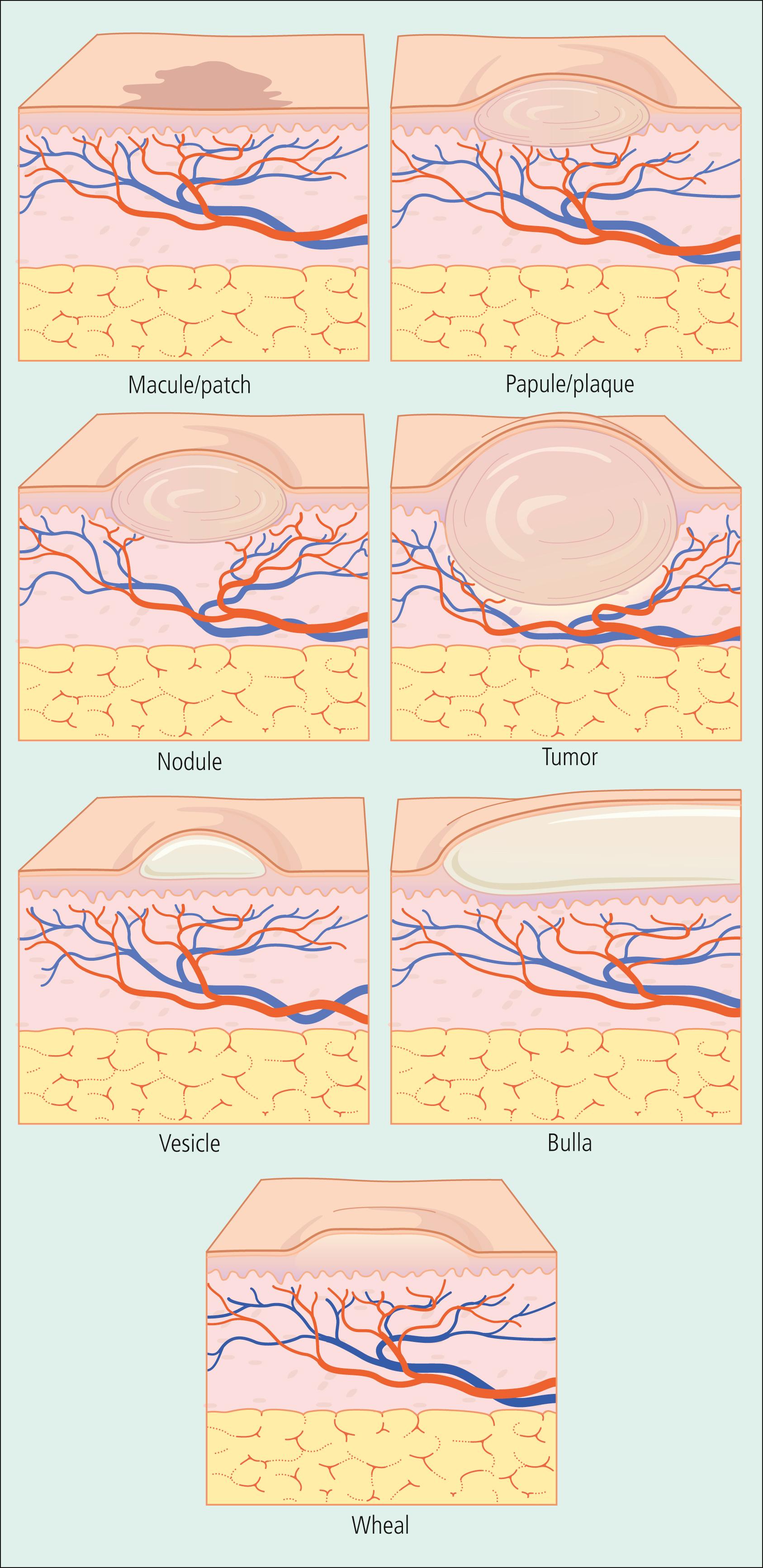
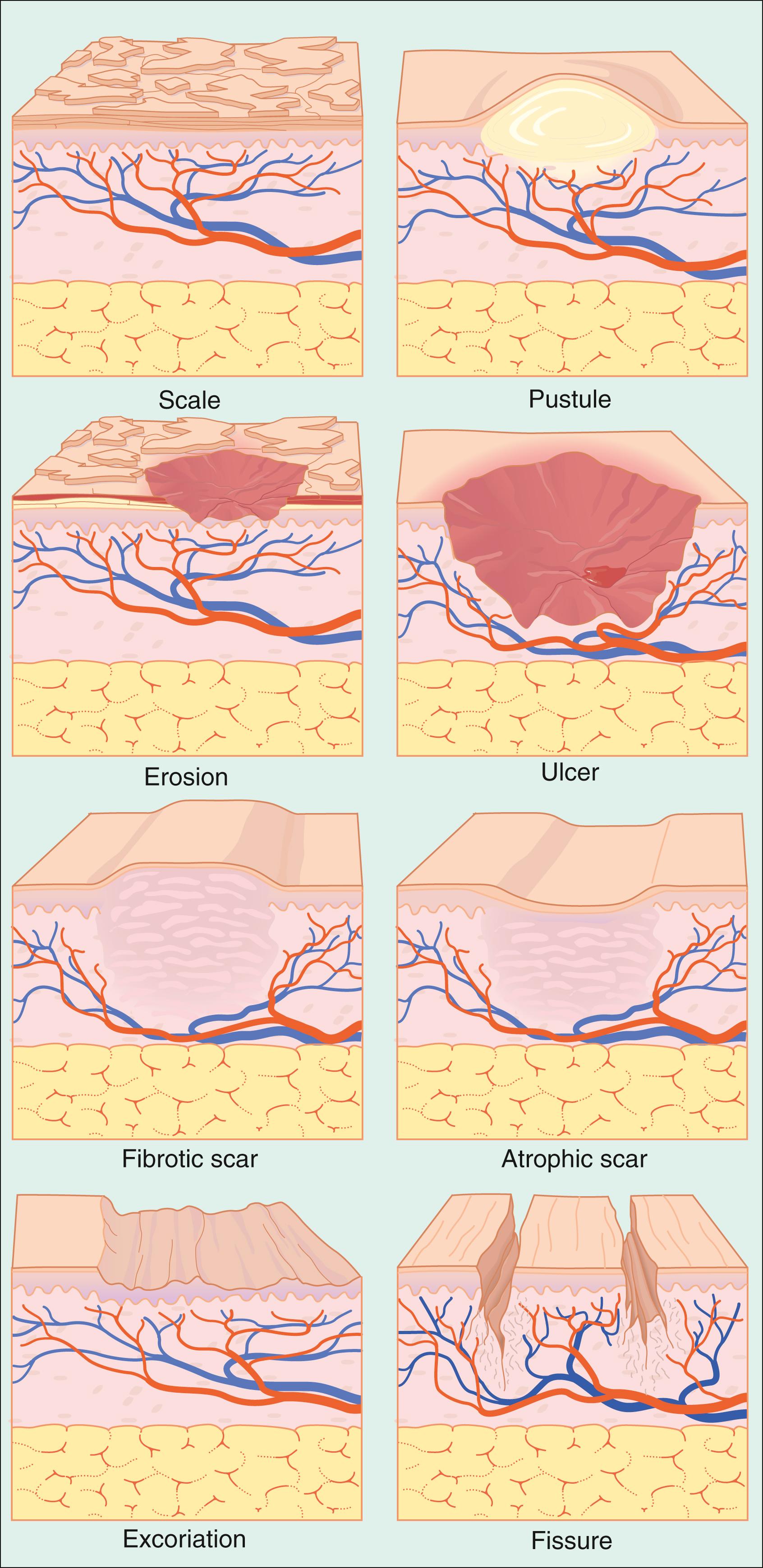
Macules and Patches. Macules are flat, circumscribed lesions that are detected because of a change in color. Pink or red macules may be caused by inflammation or vasodilation. Brown, black, or white lesions may be caused by alterations in melanin synthesis. Purple hues may represent extravasation of blood into the skin. Macules >1 cm in diameter are usually described as patches.
Papules, Nodules, Plaques, and Tumors. Papules are circumscribed, palpable, elevated solid lesions. Typically <0.5–1 cm in diameter, these lesions may be epidermal or dermal in origin and may be flat-topped or dome shaped. Plaques are elevated flat-topped lesions, larger than 1 cm in diameter, often formed by the coalescence of papules. Nodules are epidermal, dermal, or subcutaneous lesions that may, in some cases, evolve from pre-existing papules; size may range from 0.5 to 2 cm. Tumors are larger nodules >2 cm in diameter that are usually solid and well circumscribed.
Vesicles and Bullae. Vesicles are small fluid-filled lesions. Bullae are large vesicles, usually >1 cm in diameter. The tenseness or flaccidity of the blister indicates whether the level of separation is intraepidermal or subepidermal ( Fig. 61.3 and Table 61.1 ).
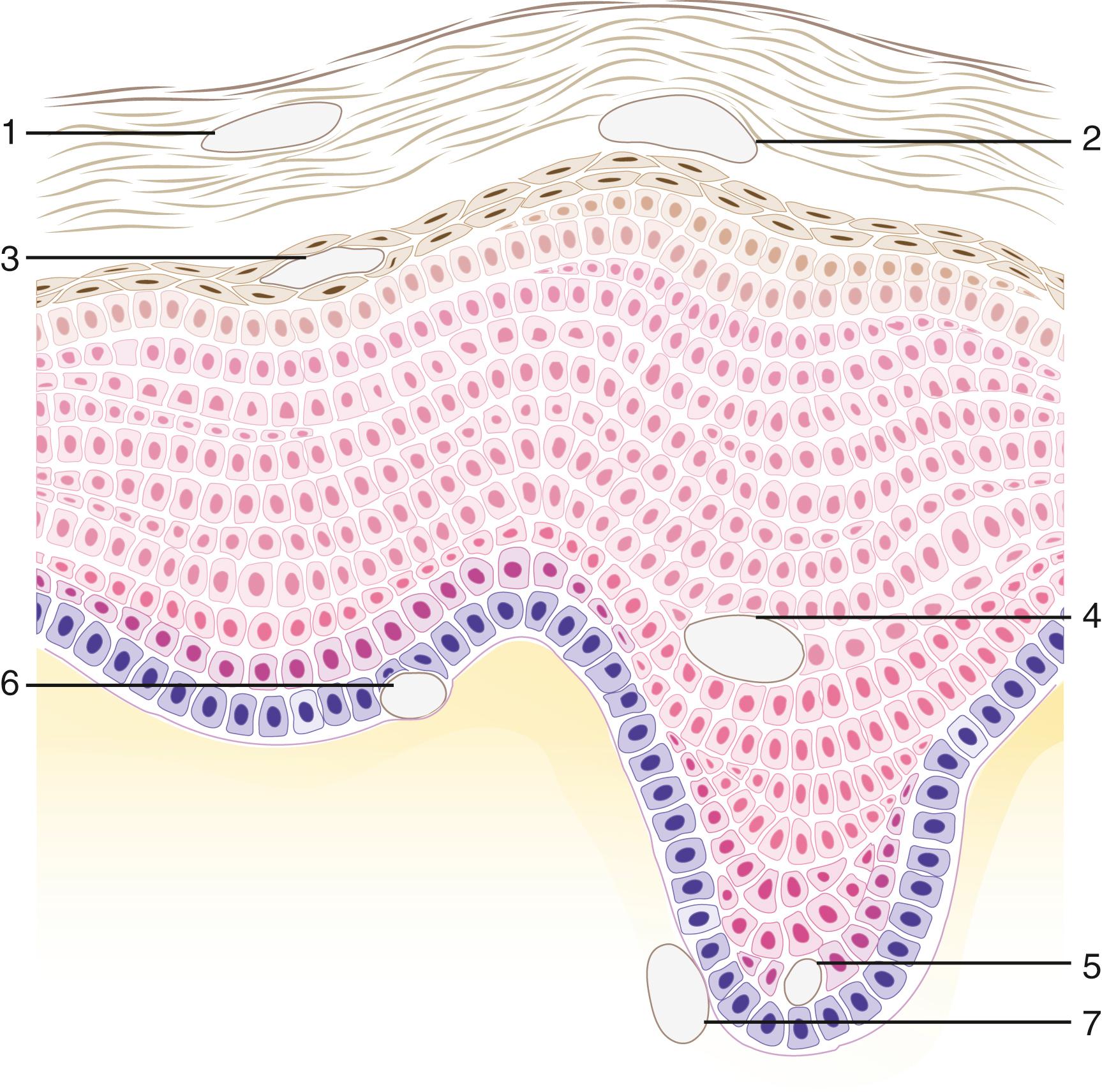
| Site of Cleavage | Clinical Examples |
|---|---|
| Intracorneal | Miliaria crystallina |
| Granular layer | Bullous impetigo Staphylococcal scalded skin syndrome Pemphigus foliaceus |
| Intraepidermal | Dermatophytosis Insect bites Incontinentia pigmenti Scabies Viral blisters |
| Suprabasal | Pemphigus vulgaris |
| Basal cell layer | Epidermolysis simplex |
| Junctional | Junctional epidermolysis bullosa |
| Subepidermal | Toxic epidermal necrolysis Dermatitis herpetiformis Recessive dystrophic epidermolysis bullosa Dominant dystrophic epidermolysis bullosa Linear IgA disease of childhood |
Pustules. Pustules are white or yellow well-circumscribed lesions that contain purulent material. Pustules do not always signify an infectious cause.
Wheals. Wheals are edematous, elevated lesions that are transient in nature and variable in shape and size. They may be white or erythematous and often have central pallor.
Telangiectases. Telangiectases are ectatic, dilated superficial blood vessels of the skin that typically blanch when pressure is applied.
Secondary lesions may represent the natural evolution of primary lesions or changes that result from external manipulation, such as scratching.
Crusts. Crusts represent serum, pus, blood, or exudate that has dried on the skin surface.
Scales. Scales appear as yellow, white, or brownish flakes on the skin surface that represent desquamation of stratum corneum.
Erosions. Erosions are moist, erythematous, circumscribed lesions that result from partial or complete loss of the epidermis. They often result from rupture of a vesicle or bulla. Erosions do not involve the dermis or subcutaneous tissue; therefore, they heal without scarring.
Ulcers. Ulcers are deeper than erosions and result from full-thickness loss of the epidermis. As they penetrate the dermis or fat, they usually heal with scarring.
Lichenification. Lichenification, or thickening of the skin, usually results from chronic scratching or rubbing. Accentuation of skin markings or hyperpigmentation is observed.
Fissures. A fissure is a linear crack in the epidermis extending to the dermis.
Atrophy. Atrophy represents loss of substance of the skin. Epidermal atrophy is characterized by loss of skin markings, increased wrinkling, and transparency with visibility of underlying vasculature. Dermal or subcutaneous atrophy results in depression of the skin with minimal, if any, epidermal changes.
Excoriations. Excoriations are linear erosions on the skin caused by scratching.
This simple and rapid test can confirm the diagnosis of dermatophyte or candidal infections. Scale is scraped with a curved blade onto a microscope slide. Hair or nail fragments can also be examined. A glass coverslip is then placed on the slide after 1–2 drops of 10–20% potassium hydroxide (KOH) are added. The slide is heated gently but not boiled, which can result in KOH crystallization and subsequent difficulty in interpretation. Dermatophyte infections are confirmed by identifying fungal hyphae , which appear as long, branching septate filaments. Pseudohyphae or budding spores are characteristic of candidiasis. Short, broad hyphae and clusters of budding cells resembling “spaghetti and meatballs” are diagnostic of tinea versicolor.
A Tzanck smear can be useful in the diagnosis of varicella-zoster virus and herpes simplex virus (HSV) infections. The smear is prepared by unroofing a blister with a curved blade and gently scraping the blister base and underside of the roof. The material is spread in a thin layer onto a glass slide. The slide is air-dried and stained with Giemsa or Wright stain. Identification of multinucleated giant cells , a syncytium of epidermal cells with multiple overlapping nuclei, establishes the diagnosis. These cells may have 2–15 nuclei and are much larger than other inflammatory cells. Although a positive result of Tzanck preparation is confirmatory, a negative test result does not rule out herpes viral infection. Viral specimens should be obtained for culture or polymerase chain reaction (PCR) to differentiate HSV from varicella-zoster virus infections.
A scabies preparation exhibiting the mite, egg, or feces (scybala) confirms the diagnosis of scabies infestation with Sarcoptes scabiei . The mite is most often found within burrows (serpiginous or elongated papules), which may have a vesicle or pustule at one end. A drop of mineral oil should be applied to the lesion so that the scraped material adheres to the blade. The site is then scraped firmly with a curved blade, which occasionally induces minimal bleeding. The material is applied to a microscope slide, another drop of mineral oil is added, and a glass coverslip is placed. Mites are eight-legged arachnids that are easily identified under low magnification. Eggs are frequently observed as smooth ovals approximately half the size of the mite. Feces are smaller than ova and appear as red-brown round pellets, often in clusters.
A Gram stain can be useful in the diagnosis and treatment of suspected bacterial infections. After the site is disinfected, the pustule or blister roof is carefully removed with a needle or straight blade. The contents of the pustule are removed in a sterile manner and spread thinly onto a glass slide. The specimen is air-dried or heat-fixed, stained, and examined microscopically. Results help determine which antibiotic, if any, is indicated. Bacterial cultures are typically obtained simultaneously.
A Wood lamp emits low-intensity ultraviolet light at 365 nm and is useful for accentuating pigmentary alterations such as those of vitiligo, piebaldism, or ash leaf macules in the newborn, and for detecting several fungal or bacterial infections. The examination is performed in a darkened room, and the lamp is held 4–6 inches from the patient’s skin. Characteristic color changes of infectious etiologies are outlined in Table 61.2 .
| Clinical Appearance | Fluorescence | Organisms/Disease |
|---|---|---|
| Brown or red thin plaques on the groin, axillae, or toe webs | Coral, red, pink | Erythrasma (Corynebacterium minutissimum) |
| Hypopigmented or hyperpigmented macules and plaques on the trunk | Pale green or yellow | Tinea versicolor ( Malassezia spp.) |
| Infection of the toe web space; often in burn patients | Bright yellow-green | Pseudomonas aeruginosa |
| Scaling of the scalp with patchy hair loss | Yellow-green | Tinea capitis (Microsporum canis, Microsporum audouinii) Not Trichophyton tonsurans |
A skin biopsy can be performed when a clinical diagnosis is unclear. Histologic evaluation of a small skin specimen may reveal changes in the epidermis, dermis, or subcutaneous tissue that confirm or rule out specific disorders. Direct immunofluorescence testing can be extremely helpful in the diagnosis of collagen vascular and autoimmune bullous diseases ( Table 61.3 ).
| Disease | Involved Skin | Uninvolved Skin | Direct IF Findings | Indirect IF Findings | Circulating Antibodies |
|---|---|---|---|---|---|
| Dermatitis herpetiformis | Negative | Positive | Granular IgA ± C3 in papillary dermis | None | IgA antiendomysial and transglutaminase antibodies |
| Bullous pemphigoid | Positive | Positive | Linear IgG and C3 band in BMZ, occasionally IgM, IgA, IgE | IgG to BMZ | IgG anti-BP180 and anti-BP230 |
| Pemphigus (all variants) | Positive | Positive | IgG in intercellular spaces of the epidermis between keratinocytes | IgG in intercellular spaces of the epidermis between keratinocytes | IgG antidesmoglein 1 and 3 (pemphigus vulgaris and foliaceus) IgA antidesmocollin 1 (IgA pemphigus) |
| Linear IgA bullous dermatosis (chronic bullous dermatosis of childhood) | Positive | Positive | Linear IgA at BMZ, occasionally C3 | Low titer, rare IgA, anti-BP180 | None |
| Discoid lupus erythematosus | Positive | Negative | Linear IgG, IgM, IgA, and C3 at BMZ (lupus band) | None | Usually ANA negative |
| Systemic lupus erythematosus | Positive | Variable; exposed to sun, 30–50%; nonexposed, 10–30% | Linear IgG, IgM, IgA, and C3 at BMZ (lupus band) | None | ANA Anti-Ro (SSA), anti-La (SSB) Anti-RNP Anti-dsDNA Anti-Sm |
| Henoch-Schönlein purpura | Positive | Positive | IgA around vessel walls | None | None |
Many skin lesions are acquired during childhood and adolescence, ranging from benign self-limited asymptomatic dermatoses to chronic skin disorders. Establishing the symptomatology and time course and evaluating the morphology of the lesions can help distinguish among childhood dermatoses.
The term papulosquamous refers to conditions in which the primary lesions are papules or plaques associated with scale. These disorders are typically benign but can be chronic and therapeutically challenging.
Pityriasis rosea is an acute, common, self-limited eruption that has no gender predilection. Although the precise cause is unknown, a viral origin is suspected because there have been reports of epidemics, clusters of cases among closely related individuals, and low recurrence rates. Furthermore, a prodrome of malaise, headache, and respiratory symptoms is occasionally observed. Pityriasis rosea has been associated with systemic reactivation of human herpesvirus (HHV)-6 and HHV-7.
The eruption usually begins with a solitary oval, pink, scaly plaque approximately 3–5 cm in diameter, typically located on the trunk or proximal extremities ( Fig. 61.4 ). Referred to as the herald patch , this finding is observed in up to 70% of cases. When the herald patch has an elevated red border and central clearing, it resembles tinea corporis. Performing a KOH preparation can differentiate these two conditions. Within 1–2 weeks after appearance of the herald patch, numerous small, pink, scaly papules or plaques arise over the trunk and proximal extremities, sparing the face and distal extremities. The lesions classically have a fine cigarette paper–like peripheral collarette of scale. These oval 0.5- to 2-cm lesions have their long axis oriented along skin lines and, when present on the trunk, result in a “Christmas tree” pattern on the back (see Fig. 61.4 ). Young children, particularly those with darker skin pigmentation, may have an “inverse” type of pityriasis rosea, with most lesions distributed on the distal extremities, face, neck, and intertriginous regions. Other variants seen in children may have lesions that are papular, vesicular, pustular, purpuric, or lichenoid.
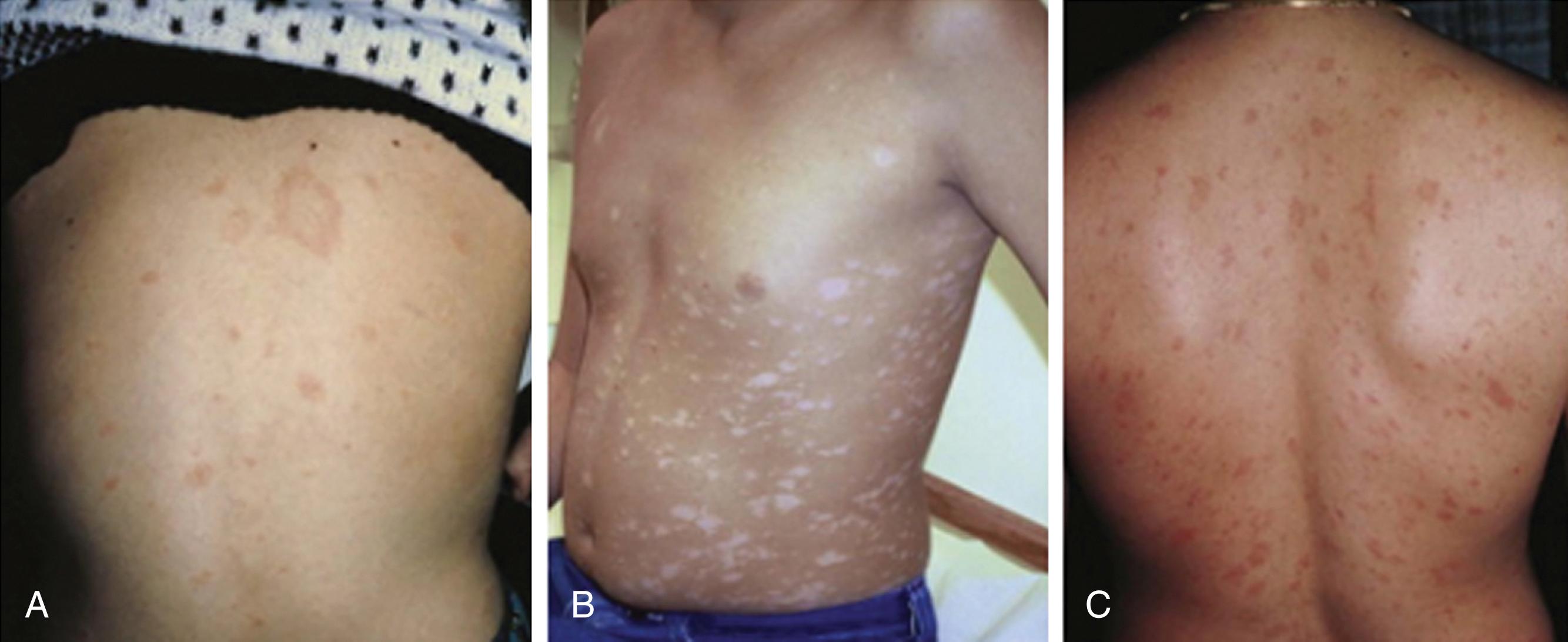
The duration of the eruption varies from 2 to 12 weeks. Pityriasis rosea is self-limited and does not necessarily require therapy, though it improves significantly with exposure to ultraviolet light. Emollients, topical corticosteroids, or oral antihistamines help relieve pruritus. Postinflammatory hypopigmentation or hyperpigmentation may persist for weeks to months, especially in dark-skinned patients. Many other dermatoses can resemble pityriasis rosea ( Table 61.4 ). In sexually active adolescents, a rapid plasma reagin (RPR) test should be obtained to rule out the possibility of secondary syphilis, especially if the palms and soles are involved. Persistence of the eruption after 3–4 months necessitates an evaluation for another diagnosis.
|
Psoriasis is an immune-mediated inflammatory skin condition characterized by well-demarcated, erythematous scaly papules and plaques located most often on the scalp, elbows, knees, genitalia, and lumbosacral regions. The course is more chronic and unpredictable than that of pityriasis rosea. Psoriasis occurs in up to 3% of the population, with approximately 30% of affected individuals manifesting symptoms before the age of 20 years. Both genders are equally affected in adulthood, but childhood psoriasis has a slight female predominance. The cause is multifactorial, though a familial predisposition is present in many affected individuals, including up to 50% of patients with childhood onset. The association between psoriasis, obesity, and metabolic syndrome has been described in both adult and pediatric patients with psoriasis; metabolic screening for individuals with moderate to severe involvement should be considered.
Psoriasis encompasses a broad spectrum of clinical manifestations, ranging from mild, asymptomatic, virtually undetectable disease to extensive, chronic, debilitating disease. The course is usually marked by recurrent flares and remissions and is often exacerbated by stress, trauma, infection, climate, hormonal factors, and particular medications.
Although morphologic variations exist, the classic lesions of plaque psoriasis are well-demarcated erythematous papules or plaques with a silvery-white scale ( Fig. 61.5 ). The lesions usually begin as small erythematous papules that gradually enlarge and coalesce to form plaques up to several centimeters in diameter. The micaceous (mica-like) scale of the psoriatic plaque is more adherent centrally than peripherally. Removal of this scale results in multiple small bleeding points, a finding referred to as the Auspitz sign that is secondary to disruption of the dilated blood vessels that are located high in the papillary dermis. Although this finding is seen in psoriasis, it is not pathognomonic. The Koebner phenomenon , another characteristic feature of psoriasis that is also observed in a number of dermatologic conditions, is an isomorphic response (i.e., development of new or larger lesions) occurring at sites of injury or trauma such as scratching, sunburn, or surgery ( Fig. 61.6 ).
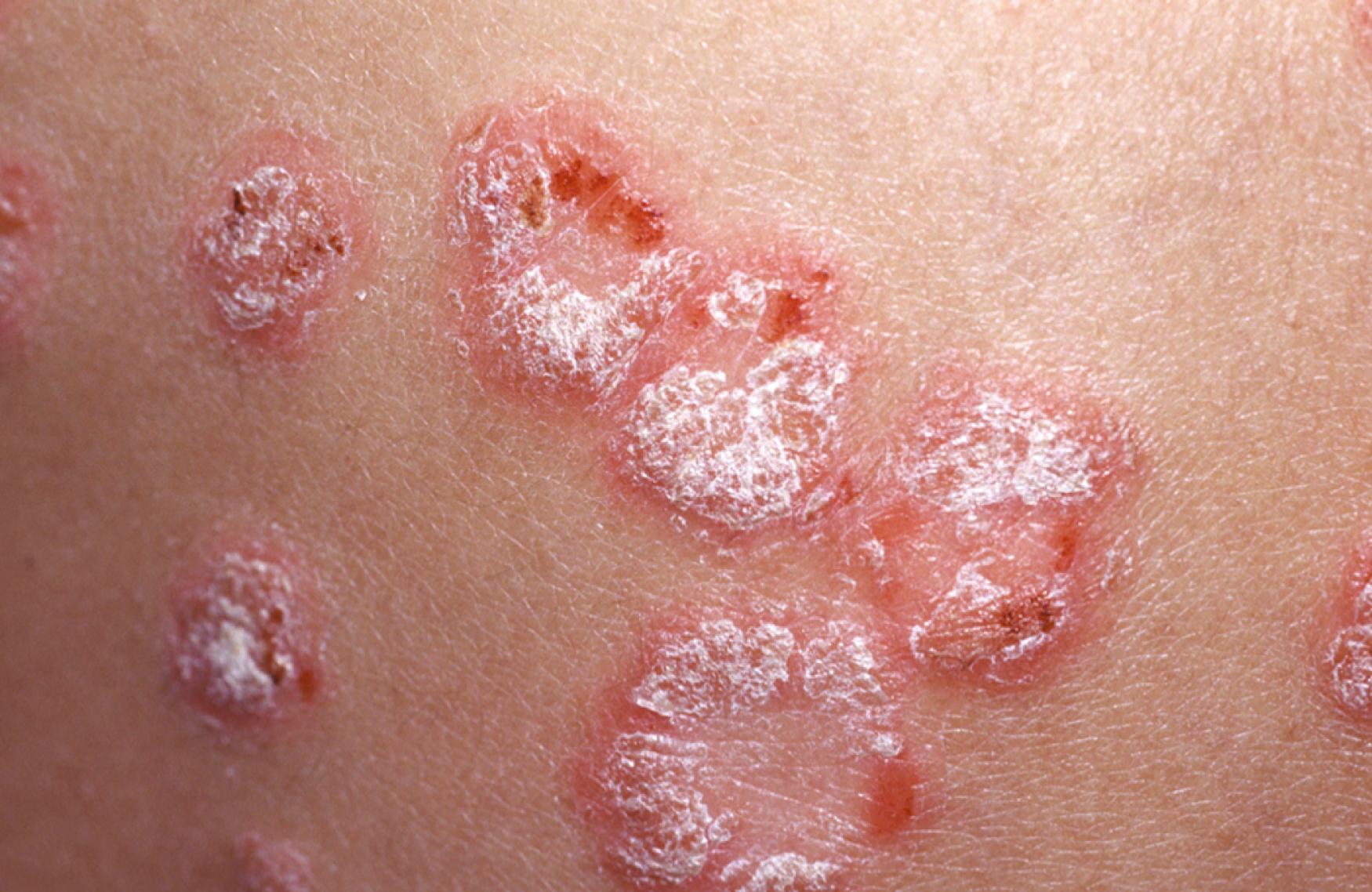
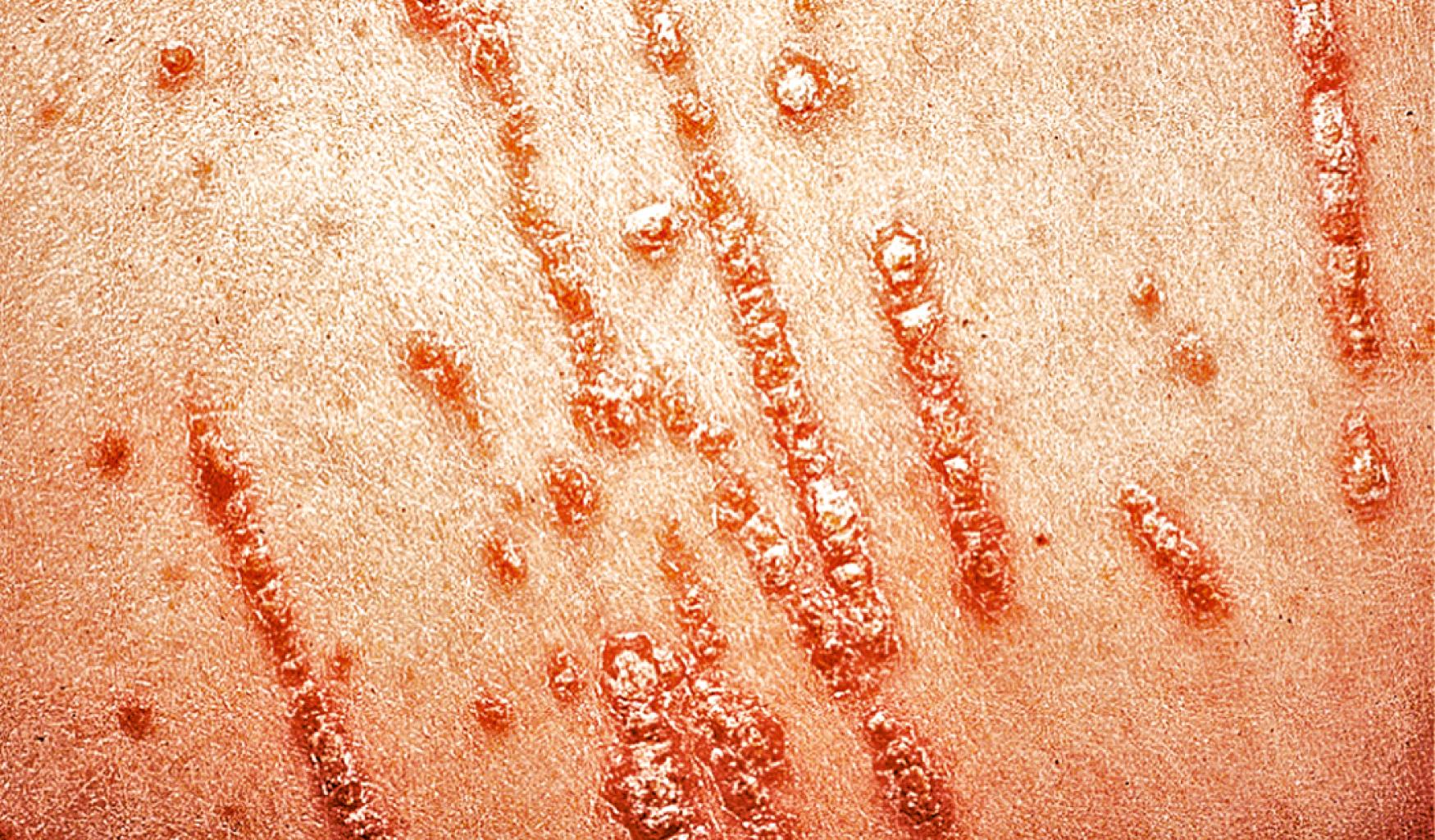
Psoriatic lesions tend to be distributed symmetrically. Although extensor surfaces are typically involved, a variant of psoriasis known as inverse psoriasis affects flexural surfaces, such as the axillae and groin. Facial involvement is more common in children than in adults. Scalp lesions are present in most children with psoriasis, wherein a diffuse, thick white scale may be accompanied by erythema. In contrast to seborrhea, psoriasis often extends beyond the hairline, affecting the forehead, ears, and neck. The lesions are variably pruritic and are generally not associated with hair loss. Scalp psoriasis tends to be more resistant to therapy than seborrheic dermatitis.
Nail abnormalities are seen in up to 50% of patients with psoriasis. Nail pits are the most common finding, identified by multiple pinpoint depressions that are irregularly distributed over the nail plate. Although nail pitting is characteristic of psoriasis, it is not pathognomonic, also being found in atopic dermatitis, alopecia areata, and trauma. Other nail changes include separation of the nail plate from the nail bed (onycholysis), subungual hyperkeratosis, discoloration, crumbling, and yellowish-brown “oil spots” on the nail plate.
Guttate psoriasis , characterized by numerous droplike lesions, is a variant commonly seen in children and young adults ( Fig. 61.7 ). The round-to-oval, pinkish red, somewhat scaly papules arise in crops and are widely distributed, particularly on the trunk. Two thirds of affected patients have a history of an upper respiratory tract infection or pharyngitis, usually streptococcal in origin, in the 1–3 weeks preceding the onset of lesions. Lesions often improve following appropriate antibiotic therapy; however, the course may range from spontaneous resolution to chronic disease.
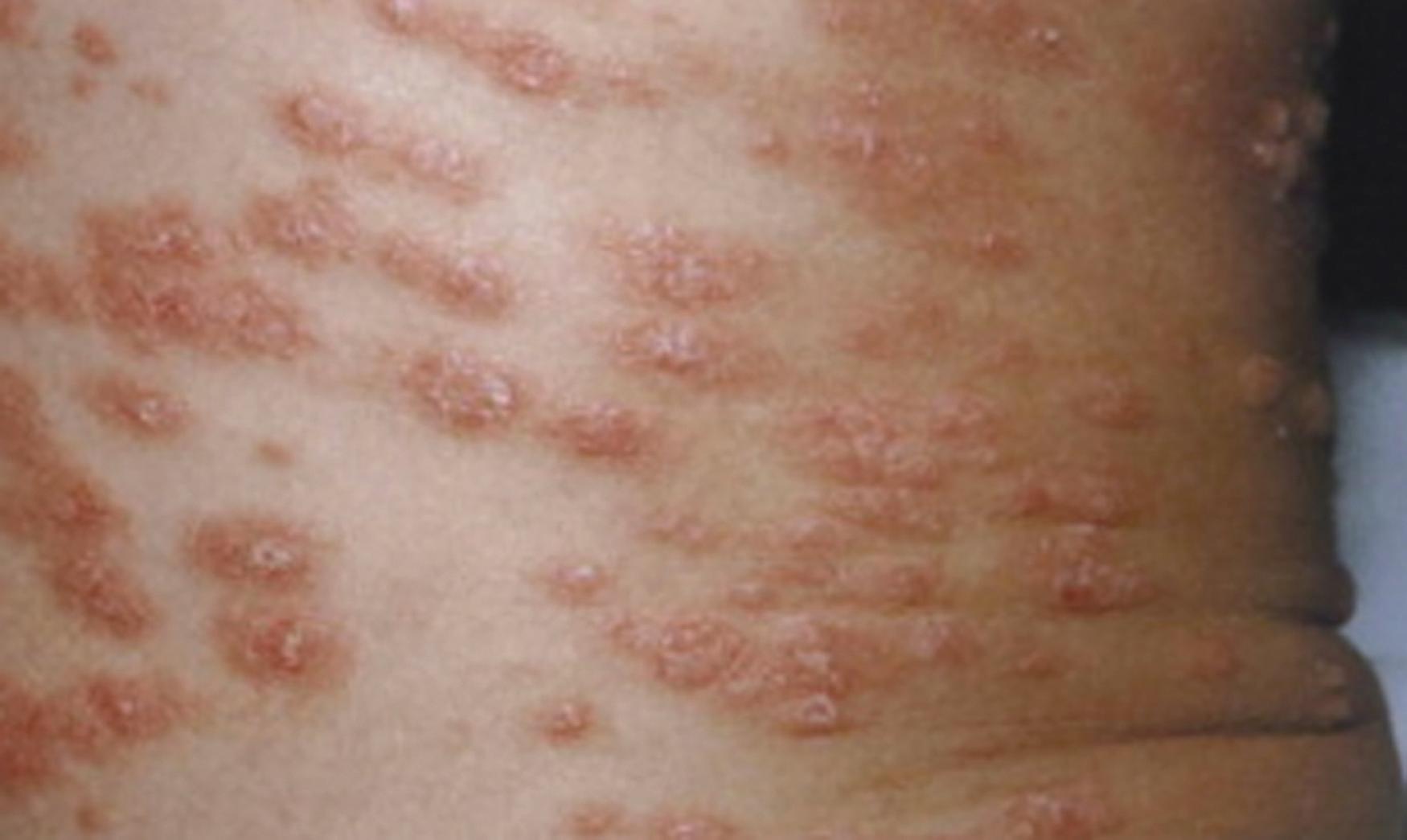
Psoriasis is usually diagnosed from the appearance of skin lesions. However, when the diagnosis is unclear, a skin biopsy may be helpful. Differential diagnosis of psoriasis includes seborrheic dermatitis, dermatophytosis, pityriasis rosea, lichen planus, atopic dermatitis, and subacute cutaneous lupus erythematosus (see Table 61.4 ).
The course of psoriasis is marked by recurrent flares and remissions, often in an unpredictable fashion. A subset of individuals gradually improves over time. Management of psoriasis varies and depends on age of the child, extent of involvement, functional limitations, and psychosocial impact. For limited disease, topical therapy (e.g., emollients, corticosteroids, vitamin D derivatives, retinoids, tar, keratolytics) alone may afford control. For more extensive or debilitating disease, the addition of phototherapy or a systemic agent (e.g., immunosuppressants, retinoids, or biologic therapy) may be necessary.
Pityriasis lichenoides can manifest in two forms: pityriasis lichenoides et varioliformis acuta (PLEVA) or pityriasis lichenoides chronica. These diseases most commonly affect children between ages 5 and 15 years, and both are believed to be part of the same clinical spectrum. PLEVA is characterized by an abrupt eruption of multiple, 2- to 4-mm, nonpruritic, variably scaly erythematous macules and papules that may progress to vesicular, necrotic, or crusted lesions. The lesions often occur in crops and are thus present in different stages. Distribution is most commonly on the trunk, but lesions may spread to the extremities. The condition may resolve spontaneously within several months, or recurrences and relapses may occur episodically for several years.
Pityriasis lichenoides chronica manifests more gradually and is characterized by pink-to-brown 2- to 5-mm papules with central adherent scale, found primarily on the trunk and proximal extremities. The clinical course is variable, and the lesions may last from months to years. After the papules recede, postinflammatory hypopigmentation or hyperpigmentation commonly occurs. Sequelae are uncommon, and the lesions usually heal without a scar. Pityriasis lichenoides chronica may initially resemble pityriasis rosea and other papulosquamous eruptions (see Table 61.4 ). Reports of cutaneous T-cell lymphoma ( mycosis fungoides ) in the setting of pityriasis lichenoides chronica exist, and the patient with a persistent or atypical eruption should be evaluated with consideration of a skin biopsy ( Fig. 61.8 ).
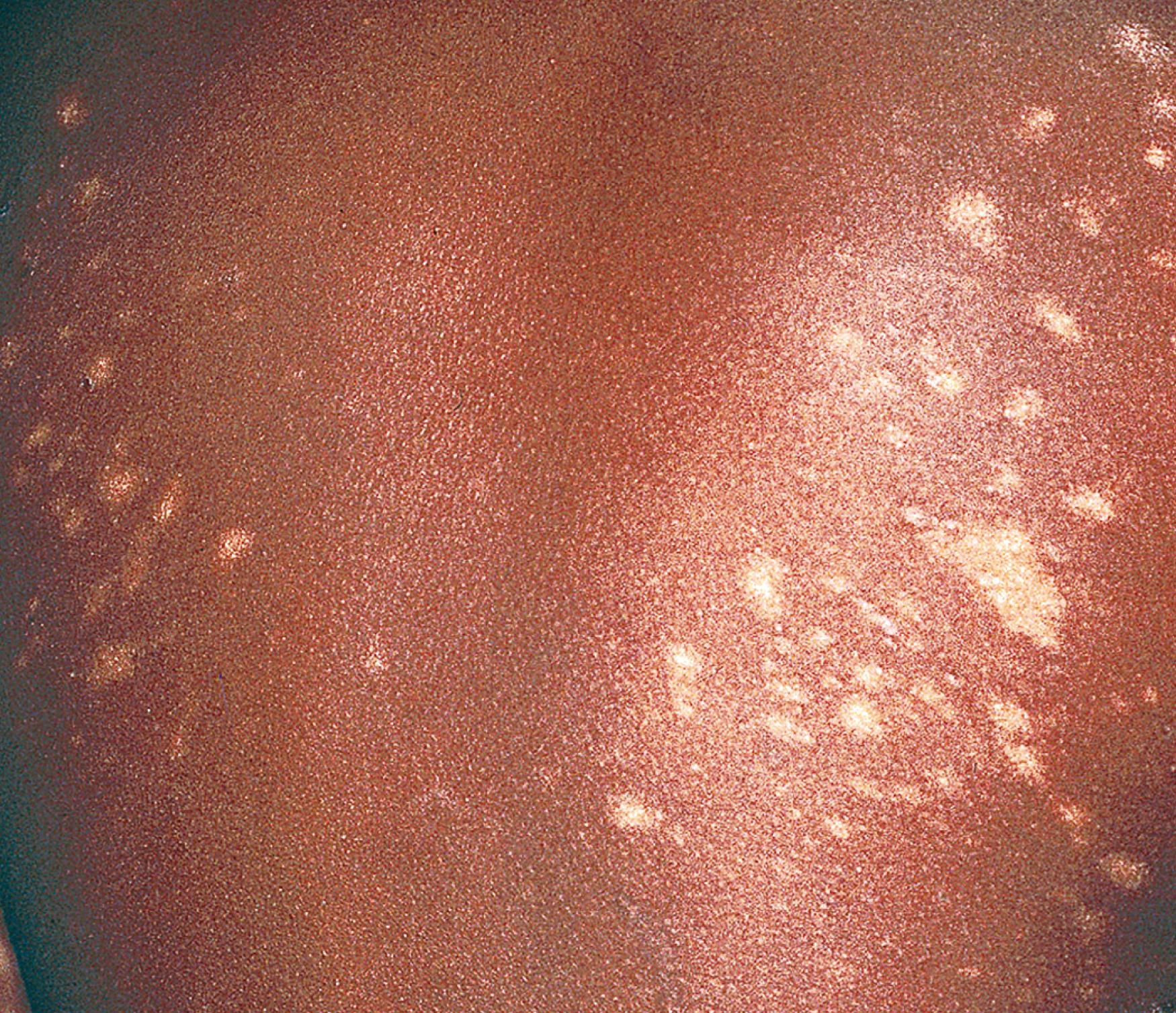
Treatment may be limited to topical emollients in an asymptomatic patient. If treatment is required, first-line agents include oral antibiotics with antiinflammatory properties (e.g., erythromycin, doxycycline) for several weeks, which have shown benefit in some children.
Lichen planus occurs in patients of all ages but is less commonly seen in children than in adults. It is characterized by the “ 5 Ps ”: purple, polygonal, planar, pruritic papules. The primary lesion is a shiny, violaceous, flat-topped papule, often with angulated borders, measuring from 2 mm to more than 1 cm in diameter. The lesions are very pruritic and demonstrate the Koebner phenomenon, which results in the development of new lesions (often in a linear configuration) at sites of scratching. The distribution may be localized or generalized, and lesions may number from few to numerous. Sites of predilection include the volar wrists, forearms, legs, genitalia, and mucous membranes. The presence of Wickham striae , a reticulated pattern of delicate white lines or streaks seen on the buccal mucosa or skin, aids in confirming the diagnosis.
Nail changes consisting of longitudinal ridging, generalized nail destruction, red or brown discoloration, subungual hyperkeratosis, and thinning of the nail plate are seen in approximately 10% of patients. Pterygium formation results from the overgrowth of fibrous tissue, which extends from the proximal nail fold to the tip of the nail, obliterating the nail plate.
Drug-induced lichenoid eruptions may mimic lichen planus. Common medications that can produce a lichenoid eruption include antihypertensives (e.g., β blockers, angiotensin-converting enzyme inhibitors), diuretics (e.g., hydrochlorothiazide), antimalarials, penicillamine, and gold salts. Rarely, tetracycline, griseofulvin, nonsteroidal antiinflammatory medications, phenytoin, and carbamazepine can be causes. Unlike other cutaneous medication reactions, the lichenoid reaction may not occur for months or years after medication initiation.
Lichen planus is typically a clinical diagnosis, though if necessary, a skin biopsy specimen can reveal specific findings. The differential diagnosis most often includes psoriasis and drug eruptions (see Table 61.4 ). If oral lesions are present, possible alternate diagnoses include aphthous stomatitis, erythema multiforme (EM), herpes simplex, or leukoplakia.
Topical corticosteroids are the treatment of choice in most cases. Lichen planus often resolves spontaneously over 1–2 years, but some cases may persist for many years. Generalized eruptions may respond to a short course of systemic corticosteroids. Oral antihistamines provide symptomatic relief.
Seborrheic dermatitis is characterized by an erythematous, scaly, symmetric eruption that occurs most often in hair-bearing and intertriginous regions. Seborrhea of infancy is discussed in Chapter 60 . In adolescents, yellowish, greasy scale of the scalp, eyebrows, nasolabial folds, nasal bridge, posterior auricular regions, and mid-chest may be accompanied by mild erythema ( Fig. 61.9 ). Immunodeficiency and histiocytic disorders may be accompanied by severe, recalcitrant seborrheic dermatitis ( Fig. 61.10 ). Although typical patients usually respond well to therapy, it is a chronic condition characterized by recurrences. It is often responsive to low-potency topical corticosteroids or topical antifungals (e.g., azoles, ciclopirox, selenium sulfide). These preparations may be available in a number of vehicles, including solutions or shampoos for the scalp. Keratolytics may be added when thicker scale is present.
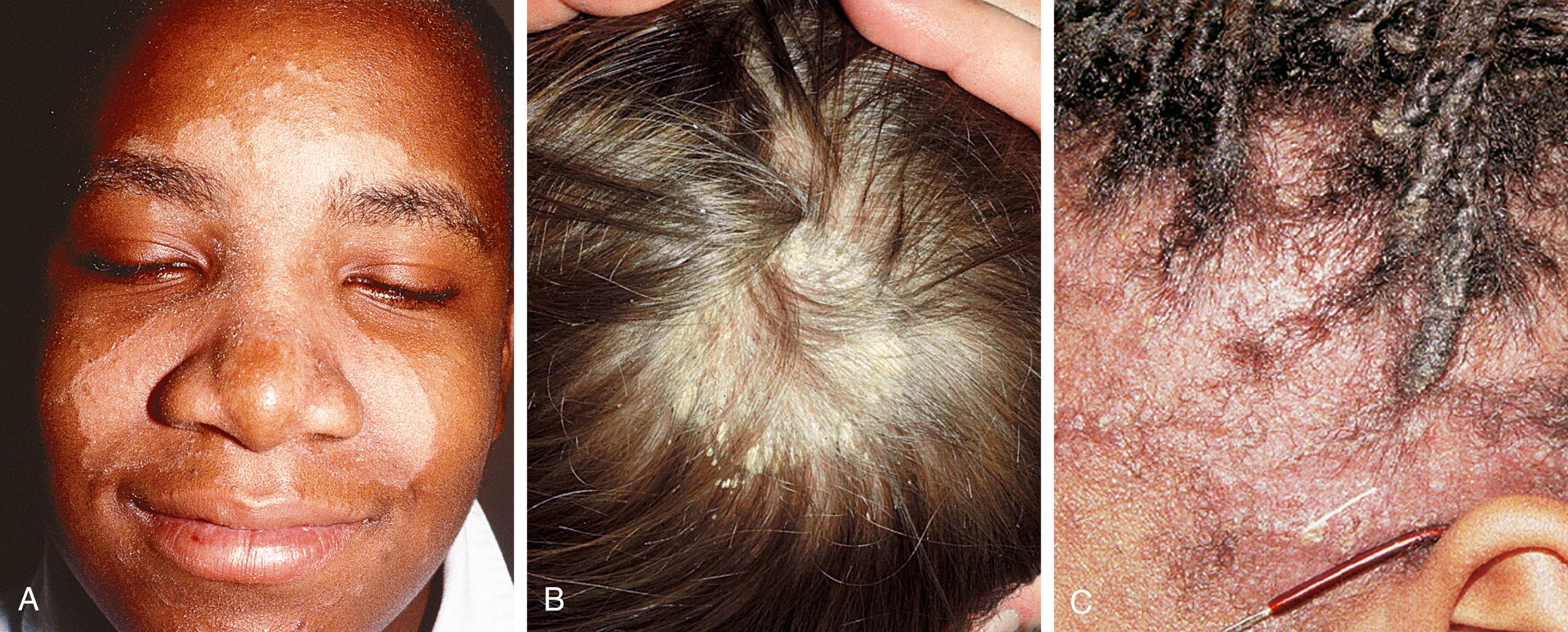
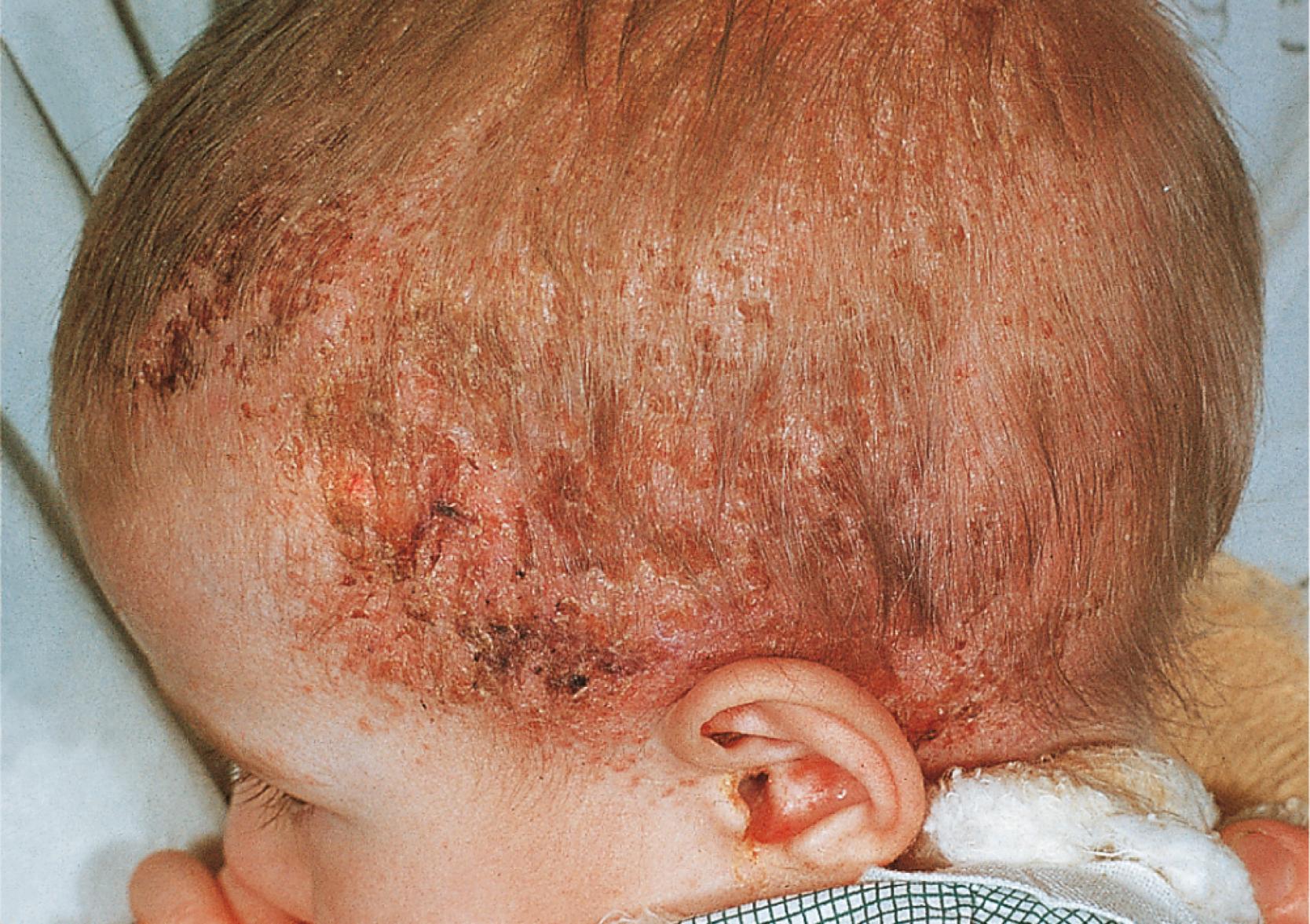
Atopic dermatitis ( eczema ) is a chronic condition characterized by pruritus, a personal or family history of atopy, and an age-dependent distribution. It is common during infancy and childhood. Up to 95% of affected individuals have signs before the age of 5 years.
Typical lesions are pink-to-red crusted or scaly plaques or papules. Some individuals have follicular accentuation, particularly on the trunk, manifested by a goosebump-like texture. Lichenification (thickened skin with exaggerated skin markings) is a feature of chronic atopic dermatitis and results from repeated rubbing and scratching. Excoriations are secondary lesions caused by scratching. Postinflammatory pigmentary changes are frequently noted, especially in darker-skinned individuals ( Fig. 61.11 ). Associated findings are noted in Table 61.5 .
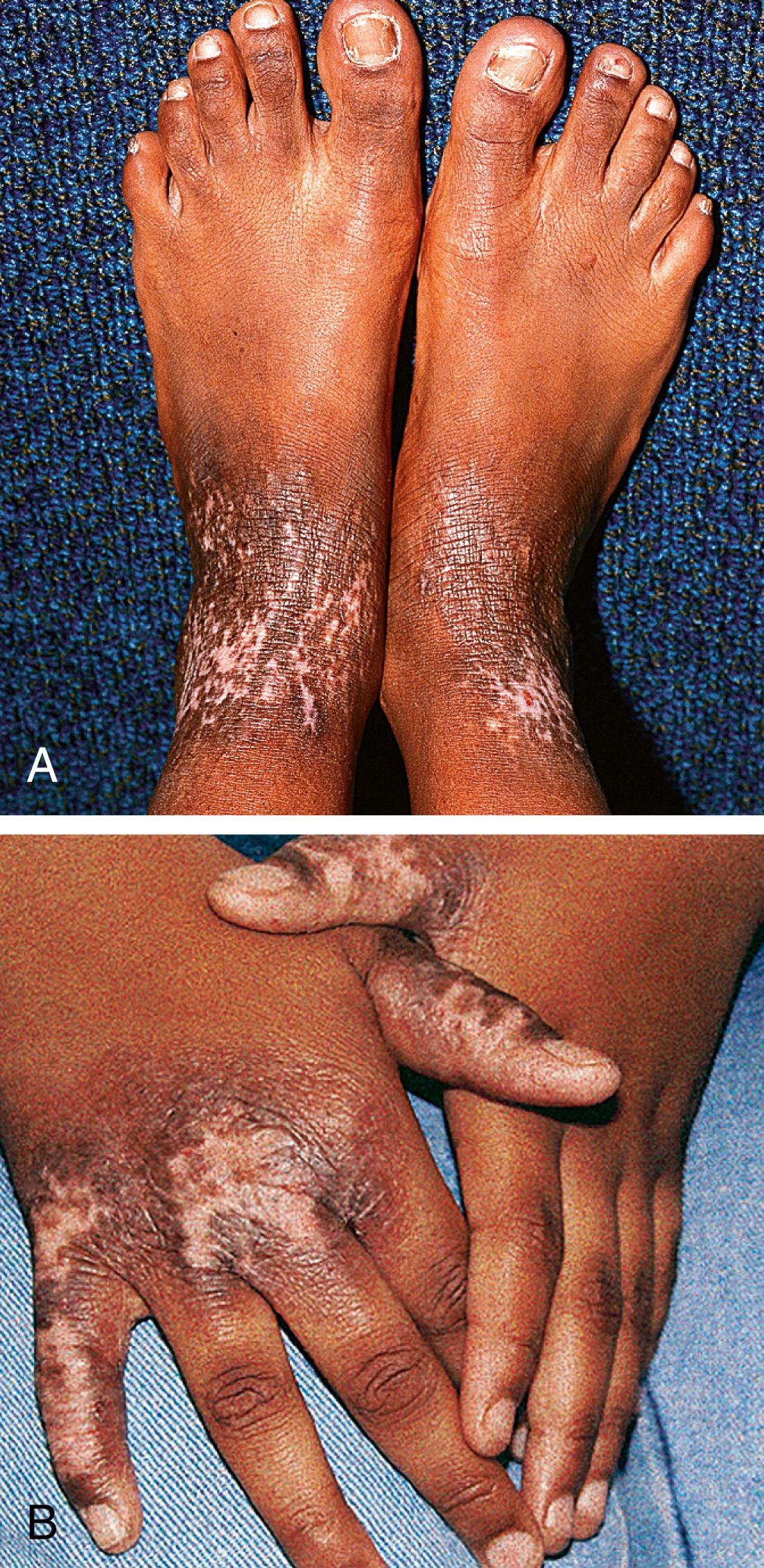
| Finding | Features |
|---|---|
| Ichthyosis vulgaris | Affects 20% of patients with atopic dermatitis Primarily involves the legs and trunk |
| Keratosis pilaris | Asymptomatic hyperkeratotic follicular papules found mainly on the extensor surfaces of the upper arms and anterior thighs, also on the face in children |
| Pityriasis alba | Hypopigmented patches on the cheeks and occasionally upper body |
| Hyperlinear palms/soles | Common |
| Dennie-Morgan fold | A double line found under the lower eyelids Not pathognomonic |
| Lichen spinulosus | More commonly seen in darker skin Pruritic grouped hyperkeratotic follicular spires |
| Eye findings | Keratoconjunctivitis, cataracts, keratoconus (abnormally shaped cornea), retinal detachment (rare) |
| Dyshidrotic eczema | Firm vesicles found on the palms and soles and lateral aspects of digits Frequently associated with hyperhidrosis |
| Nummular eczema | Well-demarcated, scaly, coin-shaped lesions usually on the lower extremities Associated with xerosis |
| Juvenile plantar dermatosis | Occasionally exudative lesions Painful erythema, scaling, cracking, and fissuring of weight-bearing surfaces of the feet Often associated with hyperhidrosis Improvement after puberty |
The distribution of the lesions tends to be age dependent. The cheeks, face, scalp, trunk, and extensor surfaces of the arms and legs are characteristically involved in the infant form. Between the ages of 2 and 10 years (childhood atopic dermatitis), the distribution predominantly involves the neck, wrists, ankles, and flexural surfaces of the extremities ( Fig. 61.12 ). After puberty, atopic dermatitis has a predilection for the face, neck, hands, and feet. The clinical features of the skin lesions are not specific to this condition, as other eczematous eruptions (contact dermatitis, seborrheic dermatitis) have a similar appearance. Laboratory tests are of limited value, and histologic findings reveal nonspecific spongiotic dermatitis. The distribution of lesions, age at onset, and history are most important for establishing the diagnosis. Obtaining a complete personal and family history of atopic diatheses is necessary.
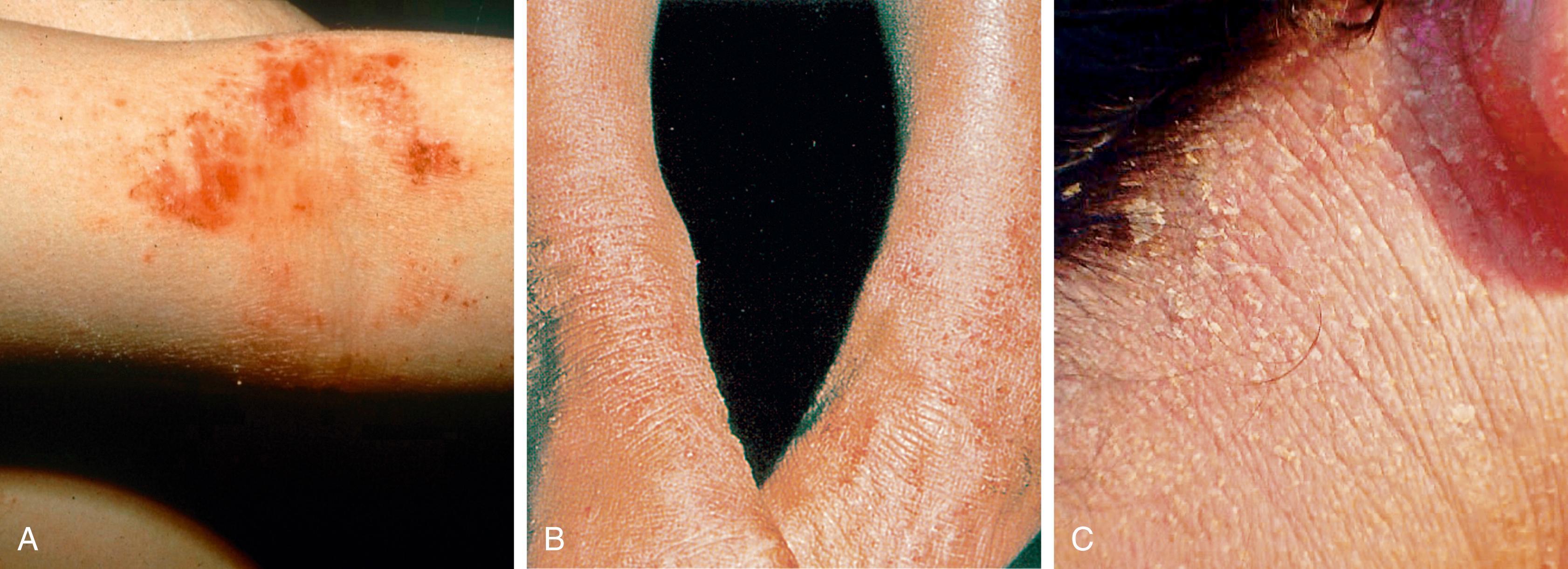
Secondary infections are the most common complication. Individuals with atopic dermatitis have increased colonization with Staphylococcus aureus . Most affected children need occasional treatment with antibiotics to eradicate secondary infection, and dilute sodium hypochlorite bleach baths can help reduce infection with S. aureus. The presence of pustules, extensive excoriations, or weeping and crusted lesions suggests the need for antibacterial therapy. Topical therapy with mupirocin may be sufficient for limited areas; however, widespread involvement may necessitate the use of oral antimicrobial agents. The increase in methicillin-resistant S. aureus (MRSA) infections has limited therapeutic options in some patients. Secondary infection with HSV is referred to as eczema herpeticum or Kaposi varicelliform eruption ( Fig. 61.13 ). Transmission may occur during routine childcare from a caretaker with a herpetic fever blister, whereby the eczematous skin becomes inoculated with HSV. The hallmark of this condition is the rapid development of numerous umbilicated vesicles and pustules. Later in the course, multiple erosions are seen, and identification of an intact vesicle may be difficult. The infection may be associated with fever and other constitutional symptoms, and expedient treatment with acyclovir is required. Hospitalization may be necessary in young infants or severely affected individuals. Recurrences of eczema herpeticum can be problematic. Eczema coxsackium is a similar condition due to entroviruses.

Other dermatologic conditions to consider in the differential diagnosis of a rash that looks like atopic dermatitis are presented in Tables 61.6 and 61.7 .
| Condition | Similarities | Differences |
|---|---|---|
| Seborrheic dermatitis | Scaly plaques | Earlier onset is typical, can be seen in older children |
| Erythroderma may be seen when severe | Increased severity associated with immunodeficiency disorders and neurologic dysfunction | |
| Pruritus minimal or absent | ||
| Well-demarcated lesions | ||
| Characteristic yellowish-salmon greasy lesions with intertriginous distribution | ||
| Contact dermatitis | ||
|
Common in infants, young children | Usually less pruritic and less eczematoid |
| May have similar distributions depending on the irritant (i.e., cheeks, chin, neck) | Diaper area distribution uncommon in atopic dermatitis | |
|
Pruritic | Well circumscribed |
| Erythematous, papulovesicular eruption | Uncommon in first few months of life | |
| Involutes spontaneously after the removal of the offending agent | ||
| Psoriasis | Scaly, red lesions | Deeper red-violaceous hue Thick micaceous scale Characteristic nail changes Sharply demarcated lesions Distinct distribution Pruritus may be less intense |
| Scabies | Frequent eczematous changes secondary to scratching, rubbing, or irritating therapy Can be very difficult to distinguish in infancy |
Polymorphous with papules, pustules, and hyperpigmented nodules Presence of burrows Isolation of a mite from skin scrapings Acute onset Affected household members |
| Langerhans cell histiocytosis | Scaly, erythematous eruption Usually begins during first year of life |
Primarily children <3 yr of age Presence of purpuric papules Associated hematologic abnormalities, hepatosplenomegaly |
| Acrodermatitis enteropathica | Vesiculobullous eczematoid lesions Onset during infancy |
Acral, periorificial distribution Associated features: failure to thrive, diarrhea, alopecia, nail dystrophy, low serum zinc levels |
| Phenylketonuria | Eczematous eruption | Hereditary Intellectual disability, seizures Diffuse hypopigmentation, blond hair, photosensitivity Elevated blood phenylalanine levels |
| Disease | Gene | Inheritance | Clinical Features | Lab Abnormalities |
|---|---|---|---|---|
| AD-HIES | STAT3 | AD, less commonly sporadic |
|
|
| DOCK8 deficiency | DOCK8 | AR |
|
|
| PGM3 deficiency | PGM3 | AR |
|
|
| WAS | WASP | XLR |
|
|
| SCID | Variable, depends on type | XLR and AR most common |
|
|
| IPEX | FOXP3 | XLR |
|
|
| Netherton syndrome | SPINK5 | AR |
|
|
An overview of the management of atopic dermatitis is presented in Table 61.8 .
| Therapeutic Modality | Indications and Recommendations |
|---|---|
| Bathing | Recommended daily for 10–15 min with warm, not hot, water. May use fragrance-free bath oils. Hydrates the skin. |
| Soaps | Mild, fragrance-free cleansers are essential. |
| Emollients | Best applied immediately after bathing/showering. Should be used as often as possible. Petroleum jelly is an ideal emollient: contains no water, additives, or preservatives and prevents evaporative water loss from the skin. Thick creams are an alternative. |
| Bleach (sodium hypochlorite) | Depending on the size of the bathtub/amount of water used, 0.25–0.5 U.S. cup (60–120 mL) of common bleach solution (6% sodium hypochlorite) is added to a full bath (40-gallon tub). Performed 2–3 times/wk to reduce Staphylococcus aureus colonization. |
| Compresses | Indicated for acute weeping lesions. Helps cool and dry the skin, reduces inflammation. Use cool tap water or aluminum acetate solutions for 20 min, 2–4 times daily. Follow with topical corticosteroid application. |
| Topical corticosteroids | Indicated to reduce pruritus and inflammation. The potency of the topical corticosteroid is determined by the age of patient, site of involvement, severity of dermatitis, and duration of therapy. Facial and intertriginous skin should be treated with low-potency preparations. Apply before emollient. Use the lowest potency that is effective. Monitor closely for potential side effects, such as striae and cushingoid features. |
| Topical immunomodulators | Tacrolimus and pimecrolimus may be effective steroid-sparing agents for mild to moderate focal involvement, particularly on the face or groin. |
| Antihistamines | Controversial whether effective in this condition. Topical formulations should be avoided. Hydroxyzine may be more effective than diphenhydramine. May induce drowsiness and help some patients sleep. Nonsedating antihistamines include cetirizine, loratadine, and fexofenadine. |
| Antibiotics | Patients with atopic dermatitis often have increased colonization with S. aureus . Use if multiple weeping excoriations, crusts, or pustules suggest secondary infection or if severe or resistant eczema is present. Treat with antistaphylococcal antibiotics; specific antibiotic is based on local susceptibilities. |
| Ultraviolet light | Useful for severe, uncontrollable atopic dermatitis. May administer narrowband ultraviolet B (NBUVB) light. |
| Tars | Useful for chronic, dry, lichenified lesions, not for acute dermatitis. |
| Environmental conditions | Environmental factors may influence the severity of the dermatitis. Some helpful measures:
|
| Systemic immunosuppressants | Oral corticosteroids should be avoided. Dupilumab, an IL-4 receptor α-antagonist, is FDA-approved for the treatment of atopic dermatitis. Cyclosporine, methotrexate, mycophenolate mofetil, and azathioprine have shown some benefit in the management of atopic dermatitis but, given the side effect profile, should be prescribed under the direction of a dermatologist. |
Telangiectases are dilated capillaries that appear as red linear stellate or punctate lesions. There are many causes of primary telangiectasia (spider angiomas, hereditary hemorrhagic telangiectasia syndrome) and secondary telangiectasia, such as collagen vascular disease. Spider angiomas are the most common of the telangiectases. In the pediatric age group, these lesions are typically not associated with systemic disease. Spider angiomas are seen most often on the face and tops of hands. They usually develop after 2 years of age. Small vessels radiate from a central punctum (arteriole), giving the appearance of a “spider.” When pressure is applied to the central punctum, the lesion blanches. Treatment, if desired, consists of gentle electrodesiccation or pulsed dye laser therapy. In some cases, spider angiomas clear without treatment.
Pyogenic granulomas are acquired vascular lesions that arise from the connective tissue of the skin or mucous membranes. These vascular nodules may be associated with antecedent trauma and represent a reactive, proliferative process. They are usually solitary, but multiple lesions occur in rare cases ( Fig. 61.14 ). Arising as small red papules, pyogenic granulomas grow rapidly and can ulcerate, leading to profuse bleeding. Histologically, these lesions resemble infantile hemangiomas (IHs). Unlike IHs, onset after the first year of life is typical, bleeding is common, spontaneous regression is rare, and recurrences may be seen. Treatment involves destruction by pulsed dye laser therapy, electrodesiccation, surgical removal, or cryotherapy.
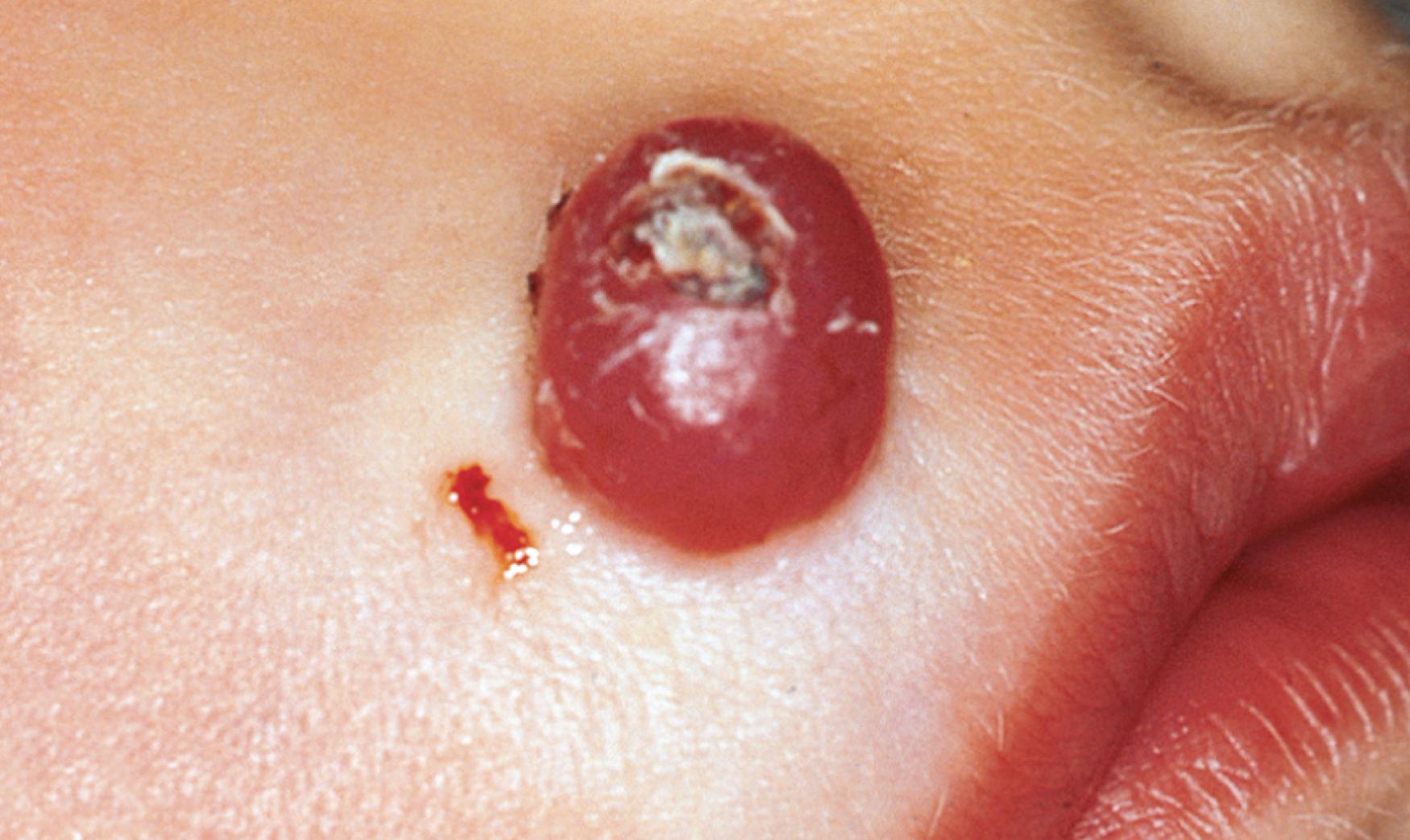
These conditions are often cosmetically disfiguring and persistent and can be markers of serious systemic diseases. Pigmentary disorders may be localized or generalized; congenital or acquired; and transient, stable, or progressive (see Chapter 60 ).
Postinflammatory hypopigmentation is a common form of acquired hypopigmentation and may follow any inflammatory skin condition, including bullous disorders, infections, eczema, psoriasis, pityriasis rosea, secondary syphilis, insect bites, acne, pityriasis lichenoides chronica, and burns. More frequently detected in darker-skinned individuals, the clinical findings consist of irregularly shaped hypopigmented patches of variable size, often ill-defined, located at sites of preceding inflammation. Postinflammatory hypopigmentation usually resolves gradually over several months, and no treatment is necessary other than photoprotection.
Pityriasis alba is characterized by poorly demarcated, slightly scaly, hypopigmented oval macules or patches located on the face (typically the cheeks), upper trunk, or extensor surfaces of the arms ( Fig. 61.15 ). The lesions generally vary from 0.5 to 2 cm in diameter, are often multiple, and are usually asymptomatic. Sun exposure may increase the contrast with normal skin, prompting patients to seek treatment. The condition may at times be associated with atopic dermatitis, and differentiating pityriasis alba from patches of atopic dermatitis–related postinflammatory hypopigmentation may be difficult. In contrast to postinflammatory hypopigmentation, the histology of pityriasis alba demonstrates low-grade inflammation. The hypopigmentation typically persists for several months to years. Although no therapeutic intervention is required, the use of emollients and low-potency topical corticosteroids may be effective.
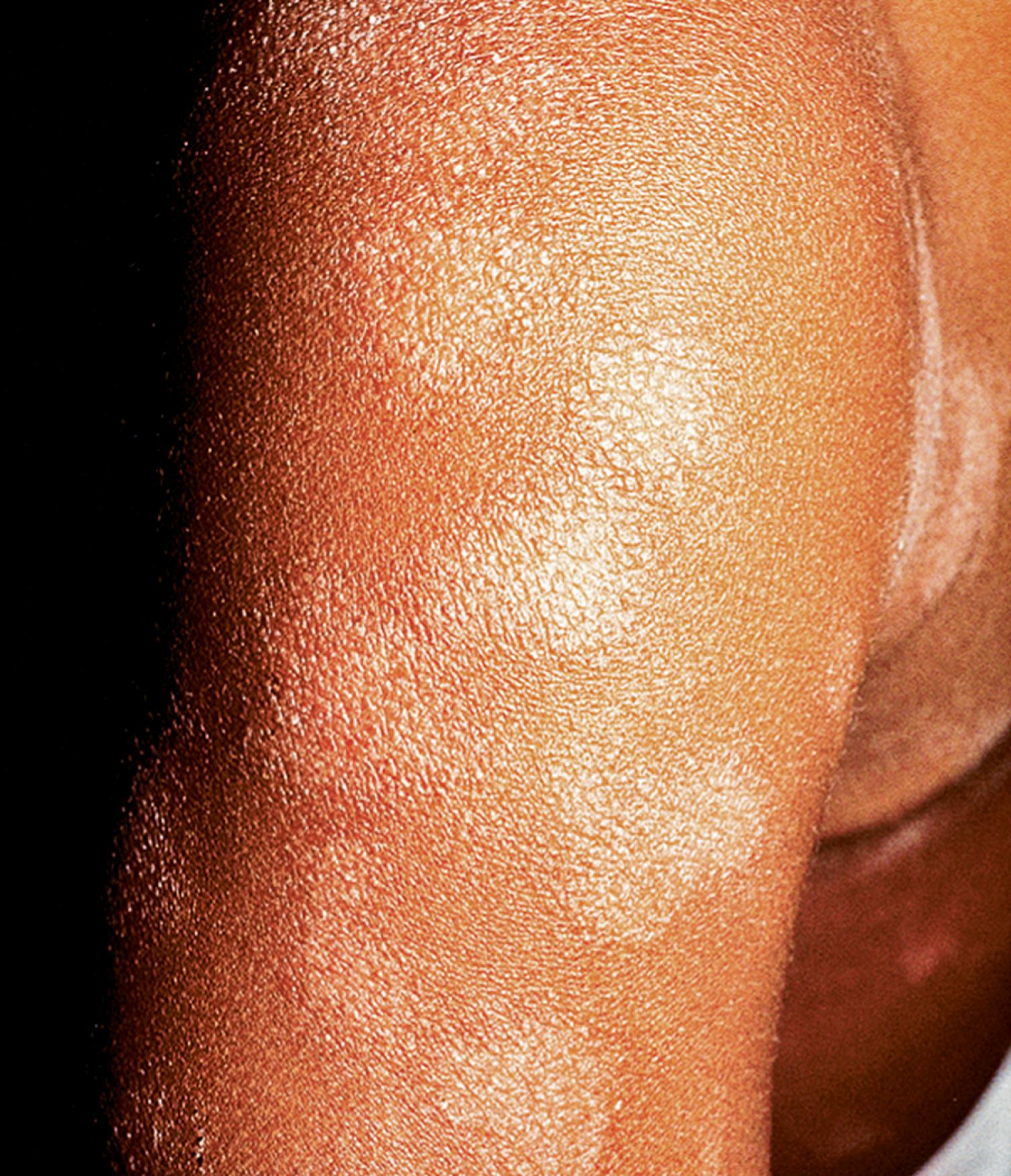
Vitiligo is an acquired disorder characterized by areas of complete loss of skin pigment resulting from the cytotoxic activity of autoreactive T cells against melanocytes. Autoantibodies against melanocyte-specific antigens have also been detected. The condition often manifests during childhood and is believed to be linked to specific pathogenic genetic variants. There is an increased incidence of autoimmune diseases in affected individuals and their families. The incidence of vitiligo (Addison disease, hypothyroidism, pernicious anemia, lupus) in persons with diabetes mellitus is also higher than that in the general population.
The onset of vitiligo may be precipitated by sunburn or other trauma. Physical findings are usually sufficient for establishing the diagnosis. Well-demarcated depigmented macules and patches that are often bilateral and symmetric are distributed over the joints of the extremities, on the periorificial areas, and within skin folds. Segmentally distributed depigmentation is more common in children than in adults. The course is unpredictable. Spontaneous complete repigmentation is unusual; however, partial repigmentation may be seen, especially within lesions of less than 2 years’ duration. Repigmentation proceeds gradually and is more likely to occur in children than in adults.
Treatment response often takes months. For limited involvement, topical corticosteroids are most frequently used, and calcineurin inhibitors provide an option in places where it may be preferable to avoid corticosteroids. For more widespread involvement, phototherapy may provide the best chance of repigmentation and may slow progression in rapidly progressive disease. Other interventions may consist of cosmetic camouflage, self-tanners, or photoprotection to reduce the contrast between affected and unaffected sites. Careful photoprotection is also recommended to prevent the development of cutaneous malignancy. Bleaching agents are another option in individuals with depigmentation of >50% of their cutaneous surface.
Lentigines are 1- to 5-mm macules that are darker than freckles and may occur on any cutaneous site, including the mucous membranes. Lentigines have no seasonal variance, and those that manifest during early childhood often disappear during adulthood. A lentigo may be clinically indistinguishable from a junctional nevus (mole); however, these lesions are histologically distinct.
Several syndromes are associated with multiple lentigines. Patients with multiple lentigines/ LEOPARD syndrome can present with isolated skin involvement with generalized lentigines or the complete syndrome (multiple lentigines, ECG abnormalities, ocular hypertelorism, pulmonic stenosis, abnormal genitalia, growth retardation, and neural deafness). Lentigines in these patients may not appear until 4–5 years of age and increase rapidly thereafter. Multiple lentigines located on the mucous membranes, especially the vermilion border of the lips and buccal mucosa, should alert the clinician to the possibility of Peutz-Jeghers syndrome , which is characteristically associated with intestinal polyposis and subsequent risk of malignant transformation and intussusception. Laugier-Hunziker syndrome also presents with lentigines involving the lips and buccal mucosa without the gastrointestinal involvement of Peutz-Jeghers. Solar lentigines occur in sun-exposed areas in older children, particularly at sites of prior sunburns.
Café-au-lait macules are well-circumscribed tan macules that usually measure <0.5 cm and may be as large as 15–20 cm in diameter ( Fig. 61.16 ). The lesions are found on any cutaneous site and may be present at birth or appear during early childhood. Although café-au-lait spots are seen in up to 20% of normal individuals and may be familial, the presence of many macules should raise the clinical suspicion of neurofibromatosis ( Table 61.9 ). The presence of six or more café-au-lait spots (>0.5 cm in prepubertal children; >1.5 cm in postpubertal children) fulfills one of the diagnostic criteria for neurofibromatosis type 1. Although the lesions are not pathognomonic, they are present in most patients with neurofibromatosis and tend to be larger and more numerous. Café-au-lait spots have also been associated with Watson syndrome, tuberous sclerosis, McCune-Albright syndrome, Turner syndrome, Bloom syndrome, ataxia-telangiectasia, Russell-Silver syndrome, Fanconi anemia, Gaucher disease, Legius syndrome, ring chromosome syndrome, and Chédiak-Higashi syndrome.
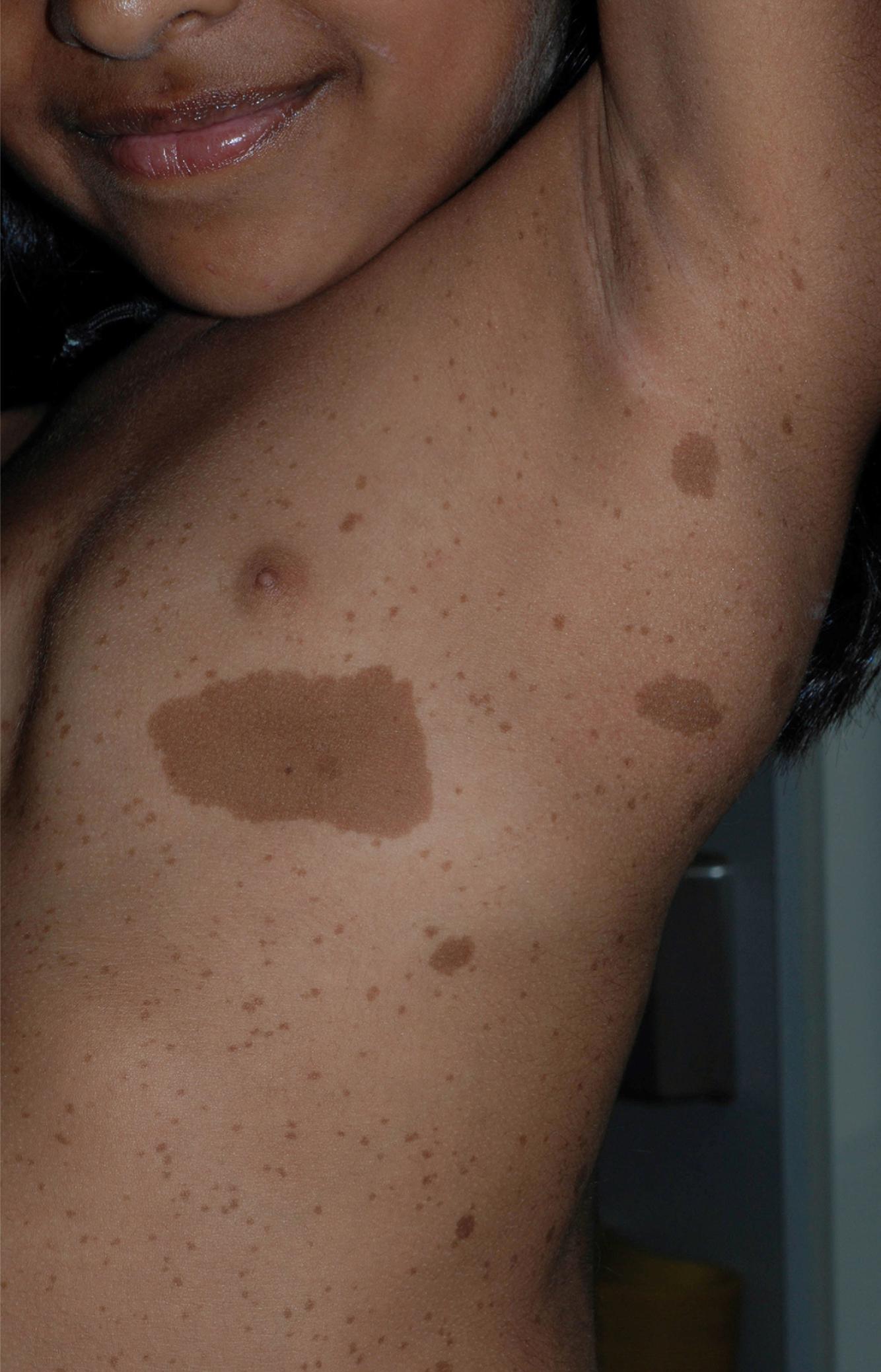
| Syndrome | Mode of Inheritance | Cutaneous Findings | Systemic Findings |
|---|---|---|---|
| Tuberous sclerosis | Autosomal dominant | Ash leaf macules Angiofibromas (adenoma sebaceum) Shagreen patches Periungual/subungual fibromas Gingival fibromas |
CNS involvement (seizures, intellectual disability, cortical tubers) Cardiac rhabdomyomas Retinal gliomas Renal carcinoma or hamartoma Renal or pulmonary cysts Skeletal abnormalities |
| Neurofibromatosis (NF) (NF1 >85% of cases) | Autosomal dominant | Café-au-lait macules (more than six measuring ≥1.5 cm in adults and >0.5 cm in children) Axillary, inguinal freckling (Crowe sign) Neurofibromas Blue-red macules and pseudoatrophic macules (involuted neurofibromas) Lisch nodules (melanocytic hamartomas of the iris) |
Acoustic neuroma in NF2 Optic glioma may result in exophthalmos, decreased visual acuity Intellectual disability (rarely) Seizure disorders (rarely) Tumors (astrocytomas) Hyperactivity, macrocephaly Learning disabilities, speech delay Osseous defects (up to 50%) Intestinal neurofibromas Endocrine disorders |
| Incontinentia pigmenti | X-linked dominant | Phase 1: inflammatory vesicles/bullae in crops over trunk and extremities, may persist weeks to months Phase 2: irregular linear verrucous lesions on one or more extremities, resolves spontaneously within several months Phase 3: brown to blue-gray hyperpigmentation, swirl-like formations on extremities and trunk; increases in intensity through second year of life, then remains stable or fades over many years Phase 4: streaked hypopigmented lesions |
Eosinophilia CNS involvement (seizures, spasticity, ↓ IQ) in 30% Spasticity Ophthalmic changes (strabismus, cataracts, optic atrophy, retinal damage) Alopecia Skeletal abnormalities Dental abnormalities |
Become a Clinical Tree membership for Full access and enjoy Unlimited articles
If you are a member. Log in here